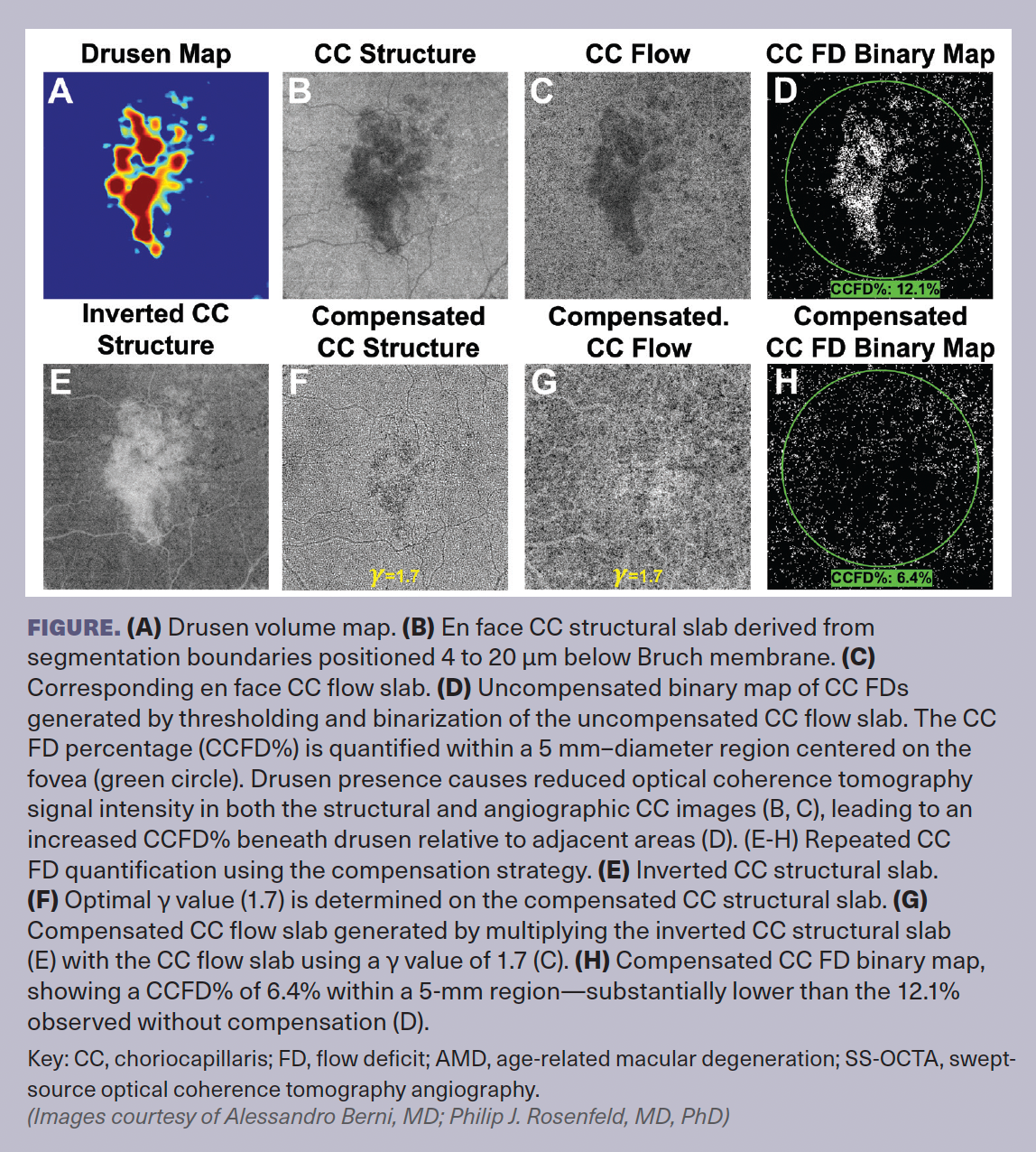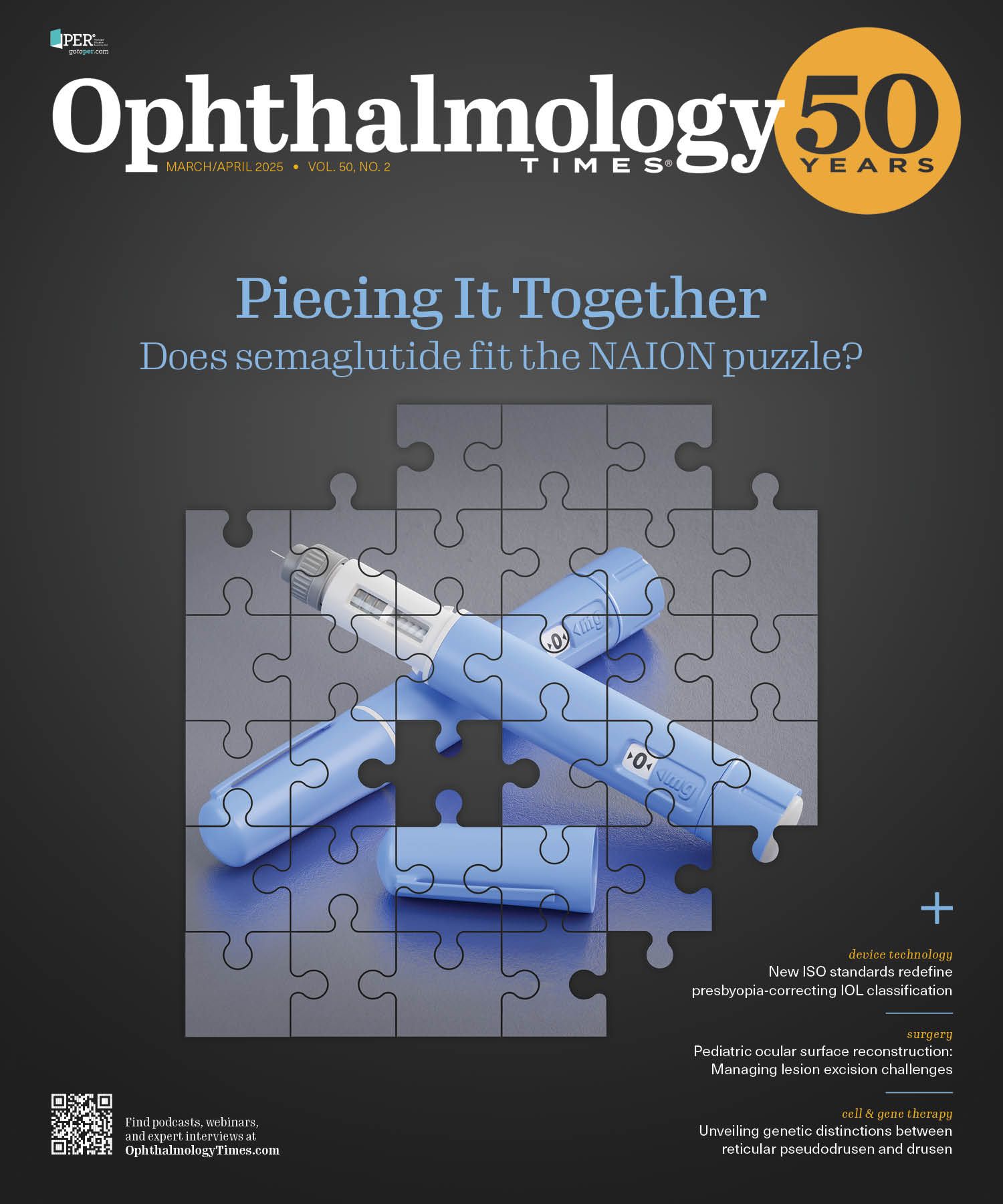Publication
Article
Digital Edition
Updated guidelines enhance choriocapillaris imaging in AMD with SS-OCTA
Key Takeaways
- SS-OCTA provides superior imaging of the choriocapillaris, crucial for understanding AMD progression, but faces challenges with drusen-affected areas.
- Compensation strategies enhance CC flow deficit accuracy by correcting signal attenuation under drusen, using structural image adjustments.
Compensation techniques in swept-source optical coherence tomography angiography improve accuracy by correcting signal loss from drusen and other artifacts
Updated guidelines for SS-OCTA compensation techniques enhance the accuracy of choriocapillaris imaging in AMD by correcting signal loss due to drusen and other artifacts, ensuring more reliable flow deficit assessments. (Image credit: AdobeStock/momius)

Swept-source optical coherence tomography angiography (SS-OCTA) has become a powerful tool for imaging the choriocapillaris (CC) and showing that decreased CC perfusion plays an important role in the progression of age-related macular degeneration (AMD).1-4 Numerous studies have demonstrated that CC flow deficits increase with age and the CC is significantly impaired within the central macula, highlighting the potential link between CC dysfunction and AMD.5,6
SS-OCTA offers distinct advantages over spectral-domain OCTA (SD-OCTA) due to its longer wavelength, improved choroidal penetration, better image quality, and denser scan patterns but imaging the CC in AMD presents unique challenges, particularly when imaging areas affected by drusen and other pathological AMD changes such as soft drusen, calcified drusen (CaD), and hyperreflective foci (HRF).7-9
Advances in compensation strategies
Recent advances in imaging techniques and compensation strategies have enhanced the accuracy of CC assessment in AMD.1,8-11 A key issue in CC imaging is the attenuation of OCT signal under drusen, which can create artificial increases in CC flow deficits (FDs). This artifact can lead to incorrect interpretations of CC perfusion status.
To address this, researchers have developed a compensation strategy that adjusts for signal loss, enabling more accurate quantification of CC FDs. By using en face structural CC images, this approach corrects attenuation artifacts and restores a more reliable flow signal. The method involves inverting the structural CC image and multiplying this latter by the CC flow image to enhance the OCTA signal in areas where it is decreased by drusen-induced attenuation.
Adjusting the inverted structural image
However, this simple multiplication is often insufficient to fully restore the signal under drusen, and subsequent observations highlighted the need for adapting the contrast of the inverted CC structural image by adjusting pixel intensity values using a power-law function. To address this limitation, we introduced a parameter, γ, which modifies the contrast by applying an exponential transformation to each pixel in the inverted structural image, raising its intensity to the power of γ. The γ parameter is greater than or equal to 1, and in most cases, a γ value between 1 and 2.5 provides an optimal balance between under- and overcompensation. This operation enhances signal compensation, allowing for greater correction in areas with severe attenuation while maintaining a balanced adjustment in regions with mild attenuation.
This compensation strategy is designed to account for the structural OCT signal loss that is apparent on CC structural slabs. Therefore, the appropriate level of compensation should be identified as the one that produces an even OCT signal across the CC structural slab. As such, the compensation strategy should first be applied to the CC structural image. However, the optimal level of compensation requires the use of objective approach to avoid over- or undercompensation.
We addressed this by analyzing the standard deviation (SD) of pixel intensities within the compensated structural image. The rationale behind this approach is that an evenly compensated CC structural image should exhibit a uniform signal distribution, minimizing variability across the slab. By testing different γ values and selecting the one that produces the lowest SD in pixel intensities, we can achieve an optimal correction tailored to each individual case. This approach ensures that OCT signal loss due to drusen-induced attenuation is adequately compensated, allowing for a more accurate assessment of CC FDs.
Consistent compensation across structural and flow images
Once the optimal γ value is determined based on the compensated structural image, this same γ value should be applied to compensate the CC flow image. This process ensures a consistent approach that provides an appropriate level of compensation for OCT signal loss, resulting in an optimally homogeneous level of OCT signal across the whole CC flow image. Consequently, any areas of decreased flow in the compensated CC flow image can be more reliably attributed to true flow deficits rather than artifacts from OCT signal loss.
This compensation strategy is shown in the Figure.

Challenges in imaging hypertransmission defects
Although compensation strategies have significantly improved CC imaging under drusen, other AMD-related lesions pose additional challenges. The retinal pigment epithelium (RPE) attenuates both incident and reflected light due to its scattering properties. In normal eyes and eyes with drusen, the compensation strategy described above is generally sufficient for CC imaging. However, when the RPE is thinned or absent, as in areas of geographic atrophy (GA), excessive light transmission into the choroid occurs, leading to what is termed choroidal hypertransmission defects (hyperTDs).12,13 These defects appear as regions of increased brightness on en face subRPE slabs (ranging from 64 to 400 µm beneath Bruch membrane) and are often associated with areas of focal hypopigmentation or GA as seen on color fundus imaging.
HyperTDs also affect en face CC slabs. The excessive light transmission results in bright regions on both CC structural and CC flow slabs, which, when inverted for compensation, appear darker. This inversion can lead to an artificial increase in CC FD measurements, making it appear as though perfusion is reduced in hyperTD regions when, in reality, the increased transmission simply alters the signal intensity.
To address this issue, we recommend either excluding hyperTDs from CC FD quantification or ensuring that they are not included in the compensation process. This can be achieved by identifying hyperTD areas on en face subRPE slabs, generating a mask, and applying this mask to the CC flow image before compensation. By doing so, the CC flow signal in these areas is preserved, preventing artificial CC FD elevations caused by excessive light transmission.
The impact of hypotransmission defects
Unlike hyperTDs, which result from increased light transmission, choroidal hypotransmission defects (hypoTDs) occur when OCT signal penetration is severely attenuated, rendering the CC undetectable. In AMD, these hypoTDs are primarily caused by HRF and CaD.7,8,14,15 HRF are well-defined lesions with a reflectivity equal to or higher than that of the RPE and are often linked to pigment migration into the retina. Their high scattering properties prevent OCT signal penetration wherever these lesions appear, leading to hypoTDs seen as intensely dark regions on the subRPE slabs. Similarly, CaD, which are drusen with a hyperreflective cap and heterogeneous internal reflectivity, scatter and absorb OCT light, preventing any meaningful imaging of the CC beneath them. Since hypoTDs represent areas where neither structural nor flow signals can be detected, they cannot be compensated.15 Attempting to apply compensation to these areas would yield unreliable CC FD measurements, as the missing signal does not represent true perfusion loss but rather an inability to image the CC.
To ensure accurate CC analysis, all hypoTDs should be identified and excluded from CC FD quantification. This can be done by generating masks based on subRPE slabs, similar to the approach used for hyperTDs, and applying these masks before binarization to prevent hypoTDs from influencing CC FD segmentation.
Longitudinal data further support the need for excluding hypoTDs. For example, in cases where HRF and CaD resolve over time, previously undetectable CC flow becomes visible again, and CC FD measurements return to levels similar to those in surrounding areas. This suggests that the high CC FD values previously observed in those regions were primarily due to the blockage of the OCT signal rather than true reductions in perfusion.
Accurate CC imaging in AMD requires a meticulous approach to ensure that observed flow deficits reflect true perfusion loss rather than imaging artifacts. Compensation strategies have proven effective in mitigating the effects of drusen-induced signal attenuation, but their application must be carefully implemented to prevent artefactual changes in CC FD measurements. Additionally, hyperTDs and hypoTDs pose significant challenges that require exclusion strategies to avoid miscalculation of the CC flow deficits.
The remaining authors have no disclosures.
Research supported by grants from Carl Zeiss Meditec, Inc., an unrestricted grant from the Research to Prevent Blindness, Inc. (New York, New York), and the National Eye Institute (P30EY014801, R01 EY028753). The funding organizations had no role in the design or conduct of the present research.
References:
Shi Y, Chu Z, Wang L, et al. Validation of a compensation strategy used to detect choriocapillaris flow deficits under drusen with swept source OCT angiography. Am J Ophthalmol. 2020;220:115-127. doi:10.1016/j.ajo.2020.06.033
Shi Y, Zhang Q, Zhou H, et al. Correlations between choriocapillaris and choroidal measurements and the growth of geographic atrophy using swept source OCT imaging. Am J Ophthalmol. 2021;224:321-331. doi:10.1016/j.ajo.2020.12.015
Iyer PG, Chu Z, Shen M, et al. Change in choriocapillaris flow deficits within tears of the retinal pigment epithelium imaged with swept-source optical coherence tomography angiography. Retina. 2022;42(11):2031-2038. doi:10.1097/IAE.0000000000003577
Li J, Liu Z, Lu J, et al. Decreased macular choriocapillaris perfusion in eyes with macular reticular pseudodrusen imaged with swept-source OCT angiography. Invest Ophthalmol Vis Sci. 2023;64(4):15. doi:10.1167/iovs.64.4.15
Zheng F, Zhang Q, Shi Y, et al. Age-dependent changes in the macular choriocapillaris of normal eyes imaged with swept-source optical coherence tomography angiography. Am J Ophthalmol. 2019;200:110-122. doi:10.1016/j.ajo.2018.12.025
Shi Y, Zhang Q, Zheng F, et al. Correlations between different choriocapillaris flow deficit parameters in normal eyes using swept source OCT angiography. Am J Ophthalmol. 2020;209:18-26. doi:10.1016/j.ajo.2019.09.017
Liu J, Laiginhas R, Shen M, et al. Multimodal imaging and en face OCT detection of calcified drusen in eyes with age-related macular degeneration. Ophthalmol Sci. 2022;2(2):100162. doi:10.1016/j.xops.2022.100162
Berni A, Shen M, Cheng Y, et al. The total macular burden of hyperreflective foci and the onset of persistent choroidal hypertransmission defects in intermediate AMD. Am J Ophthalmol. 2024;267:61-75. doi:10.1016/j.ajo.2024.06.023
Berni A, Kastner JD, Shen M, et al. Hyperreflective foci along the retinal pigment epithelium predict the onset of large choroidal hypertransmission defects in AMD. Am J Ophthalmol. Published online February 21, 2025. doi:10.1016/j.ajo.2025.02.021
Zhang Q, Zheng F, Motulsky EH, et al. A novel strategy for quantifying choriocapillaris flow voids using swept-source OCT angiography. Invest Ophthalmol Vis Sci. 2018;59(1):203-211. doi:10.1167/iovs.17-22953
Hiya FE, Cheng Y, Shen M, et al. A novel grid strategy for correlating focal macular anatomic changes with focal changes in choriocapillaris perfusion. Invest Ophthalmol Vis Sci. 2024;65(14):5. doi:10.1167/iovs.65.14.5
Shi Y, Yang J, Feuer W, Gregori G, Rosenfeld PJ. Persistent hypertransmission defects on en face OCT imaging as a stand-alone precursor for the future formation of geographic atrophy. Ophthalmol Retina. 2021;5(12):1214-1225. doi:10.1016/j.oret.2021.02.004
Laiginhas R, Shi Y, Shen M, et al. Persistent hypertransmission defects detected on en face swept source optical computed tomography images predict the formation of geographic atrophy in age-related macular degeneration. Am J Ophthalmol. 2022;237:58-70. doi:10.1016/j.ajo.2021.11.001
Laiginhas R, Liu J, Shen M, et al. Multimodal imaging, OCT B-scan localization, and en face OCT detection of macular hyperpigmentation in eyes with intermediate age-related macular degeneration. Ophthalmol Sci. 2022;2(2):100116. doi:10.1016/j.xops.2022.100116
Cheng Y, Hiya F, Li J, et al. Calcified drusen prevent the detection of underlying choriocapillaris using swept-source optical coherence tomography angiography. Invest Ophthalmol Vis Sci. 2024;65(6):26. doi:10.1167/iovs.65.6.26
Newsletter
Don’t miss out—get Ophthalmology Times updates on the latest clinical advancements and expert interviews, straight to your inbox.







